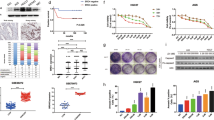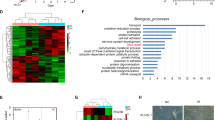Abstract
RB Binding Protein 8 (RBBP8) was previously reported being involved in DNA double-strand break (DSB) repair in cancers. However, there is no systematic study about the specific functions and related mechanisms of RBBP8 in gastric carcinogenesis. Through immunohistochemistry staining of paired gastric cancer (GC) tissues, adjacent high-grade intraepithelial neoplasia (HGIEN) tissues, and non-cancerous tissues, we found RBBP8 expression was upregulated in both HGIEN and GC tissues. Functional experiments showed the knockdown of RBBP8 inhibited cell proliferation and colony formation ability. This is mainly achieved through the role of RBBP8 in facilitating G1/S transition and promoting Cyclin D1 and CDK4 level. Then the interaction between RBBP8, BRCA1, and CtBP was revealed by co-immunoprecipitation (co-IP) and immunofluorescence confocal imaging. Moreover, we found RBBP8 acted as an adapter in this complex and RBBP8 overexpression enhanced the nucleus location of BRCA1. RBBP8 overexpression could inhibit P21 expression and HDAC (histone deacetylase) inhibitor Trichostatin A (TSA) eliminated this effect. The HDAC activity of CtBP-RBBP8-BRCA1 complex was also further verified by HDAC activity assay. Through Chromatin immunoprecipitation (ChIP), we found RBBP8 could induce P21 promoter histone deacetylation and inhibit P21 transcription. In conclusion, we found RBBP8 could promote the G1/S transition of GC cells by inhibiting P21 level. Moreover, we revealed the chromatin modification role of RBBP8, which could suppress the histone acetylation level of P21 promoter by recruiting CtBP co-repressor complex to BRCA1 binding site.
This is a preview of subscription content, access via your institution
Access options
Subscribe to this journal
Receive 50 print issues and online access
$259.00 per year
only $5.18 per issue
Buy this article
- Purchase on Springer Link
- Instant access to full article PDF
Prices may be subject to local taxes which are calculated during checkout







Similar content being viewed by others
References
Bray Freddie, Ferlay Jacques, Soerjomataram Isabelle, Siegel RebeccaL, Torre LindseyA, Jemal Ahmedin. Global cancer statistics 2018: GLOBOCAN estimates of incidence and mortality worldwide for 36 cancers in 185 countries. CA Cancer J Clin. 2018;0:1–31.
D’Angelica M, Gonen M, Brennan MF, Turnbull AD, Bains M, Karpeh MS. Patterns of initial recurrence in completely resected gastric adenocarcinoma. Ann Surg. 2004;240:808–16.
Yoo CH, Noh SH, Shin DW, Choi SH, Min JS. Recurrence following curative resection for gastric carcinoma. Br J Surg. 2000;87:236.
Dan L, Ming L, Jian L, Yang Z, Qi F, Zhou M, et al. The patterns and timing of recurrence after curative resection for gastric cancer in china. World J Surgical Oncol. 2016;14:305.
Jemal A, Siegel R, Ward E, Murray T, Xu J, Thun MJ. Cancer statistics. CA Cancer J Clin. 2007;57:43–66.
Miao L, Lei R, Mei G, Pathology DO, Hospital AT. Expression of HER-2 protein in advanced gastric cancer of different sites. Chinese. J Gastroenterol. 2014;19:618–20.
Zhu G, Chunwei XU, Fang M, Zhang Y, Yang LI. Detection of Her-2/neu expression in gastric cancer: Quantitative PCR versus immunohistochemistry. Exp Therapeut Med. 2014;8:1501–7.
Bang Y, Chung H, Xu J, Lordick F, Sawaki A, Alsakaff N, et al. Pathological features of advanced gastric cancer (GC): relationship to human epidermal growth factor receptor 2 (HER2) positivity in the global screening programme of the ToGA trial. J Clin Oncol. 2009;27(Suppl 15S):a4556.
Chinnadurai G, Subramanian T, Vijayalingam S. RBBP8 (retinoblastoma binding protein 8). Atlas Genet Cytogenet Oncol Haematol. 2009;13:282–284.
Limbo O, Chahwan C, Yamada Y, de Bruin RA, Wittenberg C, Russell P. Ctp1 is a cell-cycle-regulated protein that functionswith Mre11 complex to control double-strand break repair by homologous recombination. Mol Cell. 2007;28(Oct):134–46.
Sartori AA, Lukas C, Coates J, Mistrik M, Fu S, Bartek J, et al. Human RBBP8 promotes DNA endresection. Nature. 2007;450(Nov):509–14.
Huertas P, Jackson SP, Huertas P, Jackson SP. Human RBBP8 mediates cell cycle control of DNA end resection and double strand break repair. J Biol Chem. 2009;284:9558–65.
Yu X, Chen J. Dna damage-induced cell cycle checkpoint control requires ctip, a phosphorylation-dependent binding partner of brca1 c-terminal domains. Mol Cell Biol. 2004;24:9478.
Yu X, Baer R. Nuclear localization and cell cycle-specific expression of ctip, a protein that associates with the brca1 tumor suppressor. J Biol Chem. 2000;275:18541.
Li S, Ting NS, Zheng L, Chen PL, Ziv Y, Shiloh Y, et al. Functional link of BRCA1 and ataxia telangiectasia gene product in DNA damage response. Nature. 2000;406:210.
Chinnadurai G. The transcriptional corepressor ctbp: a foe of multiple tumor suppressors. Cancer Res. 2009;69:731–4.
Zhang Q, Wang SY, Nottke AC, Rocheleau JV, Piston DW, Goodman RH. Redox sensor CtBP mediates hypoxia-inducedt umor cell migration. Proc Natl Acad Sci USA. 2006;103:9029–33.
Cui J, Chen Y, Chou WC, Sun L, Chen L, Suo J, et al. An integrated transcriptomic and computational analysis for biomarker identification in gastric cancer. Nucleic Acids Res. 2011;39:1197–207.
Chen X, Leung SY, Yuen ST, Chu KM, Ji J, Li R, et al. Variation in gene expression patterns in human gastric cancers. Mol Biol Cell. 2003;14:3208–15.
Peterson Shaun Eric, Li YinYin, Wu-Baer Foon, Chait Brian, Baer Richard, Yan Hong, et al. Activation of dsb processing requires phosphorylation of ctip by atr. Mol Cell. 2013;49:657–67.
Xiong Y, Hannon GJ, Zhang H, Casso D, Kobayashi R, Beach D. P21 is a universal inhibitor of cyclin kinases. Nature. 1993;366:701–4.
Abbas T, Dutta A. P21 in cancer: intricate networks and multiple activities. Nat Rev Cancer. 2009;9:400–14.
Lu M, Arrick B. Transactivation of the p21 promoter by BRCA1 splice variants in mammary epithelial cells: evidence for both common and distinct activities of wildtype and mutant forms. Oncogen. 2000;19:6351.
Chai YL, Cui J, Shao N, Shyam E, Reddy P, Rao VN. The second brct domain of brca1 proteins interacts with p53 and stimulates transcription from the p21waf1/cip1 promoter. Oncogene. 1999;18:263–8.
Wang YG, Wang N, Li GM, Fang WL, Wei J, Ma JL, et al. Mechanisms of trichostatin a inhibiting ags proliferation and identification of lysine-acetylated proteins. World J Gastroenterol. 2013;19:3226–40.
Nevins JR. The Rb/E2F pathway and cancer. Hum Mol Genet. 2001;10:699–703.
Deng CX, Brodie SG. Roles of brca1 and its interacting proteins. Bioessays. 2015;22:728–37.
Somasundaram K, Zhang H, Zeng YX, Houvras Y, Peng Y, Zhang H, et al. Arrest of the cell cycle by the tumor-suppressor brca1 requires the cdk-inhibitor p21waf1/cip1. Nature. 1997;389:187–90.
Kuppuswamy M, Vijayalingam S, Zhao LJ, Zhou Y, Subramanian T, Ryerse J, et al. Role of the PLDLS-binding cleft region of CtBP1 in recruitment of core and auxiliary components of the corepressor complex. Mol Cell Biol. 2008;28:269–81.
Deroanne CF, Bonjean K, Servotte S, Devy L, Colige A, Clausse N, et al. Histone deacetylase inhibitors as anti-angiogenic agent altering vascular endothelial growth factor signaling. Oncogene. 2002;21:427–36.
Berger SL. Histone modifications in transcriptional regulation. Curr Opin Genet Dev. 2002;12:142–8.
Gray SG, Teh BT. Histone acetylation/deacetylation and cancer: an “open” and “shut” case? Curr Mol Med. 2001;1:401–29.
Kim DongHoon, Kim Minjung, Kwon HoJeong. Histone deacetylase in carcinogenesis and its inhibitors as anti-cancer agents. Biochem. Mol Bio. 2003;36:110–9.
Chinnadurai G. CtBP, an unconventional transcriptional corepressor in development and oncogenesis. Mol Cell. 2002;9:213–24.
Lord CJ, Ashworth A. PARP inhibitors: synthetic lethality in the clinic. Science. 2017;355:1152–8.
Murai J, Huang SY, Das BB, Renaud A, Zhang Y, Doroshow JH, et al. Trapping of PARP1 and PARP2 by Clinical PARP Inhibitors. Cancer Res. 2012;72:5588.
Acknowledgements
We thank Prof. Guangyong Chen and Ms Rui Xu, Department of Pathology, Beijing Friendship Hospital for the supply of tissue materials and the score assessment for IHC. We thank the Clinical Data and Biobank Resource of Beijing Friendship Hospital for their help in sample collection.
Funding
This work was completely supported by grants from the National Natural Science Foundation of China (81702314); Funding Program for Excellent Talents of Beijing (2017000021469G212); The Digestive Medical Coordinated Development Center of Beijing Municipal Administration of Hospitals (XXZ0201); Beijing Municipal Administration of Hospitals’ Youth Programme (QML20180108).
Author information
Authors and Affiliations
Corresponding authors
Ethics declarations
Conflict of interest
The authors declare that they have no conflict of interest.
Additional information
Publisher’s note Springer Nature remains neutral with regard to jurisdictional claims in published maps and institutional affiliations.
Supplementary information
Rights and permissions
About this article
Cite this article
Yu, Y., Chen, L., Zhao, G. et al. RBBP8/CtIP suppresses P21 expression by interacting with CtBP and BRCA1 in gastric cancer. Oncogene 39, 1273–1289 (2020). https://doi.org/10.1038/s41388-019-1060-7
Received:
Revised:
Accepted:
Published:
Issue Date:
DOI: https://doi.org/10.1038/s41388-019-1060-7
This article is cited by
-
Kelch-like proteins in the gastrointestinal tumors
Acta Pharmacologica Sinica (2023)
-
Chromatin and noncoding RNA-mediated mechanisms of gastric tumorigenesis
Experimental & Molecular Medicine (2023)
-
A novel RBBP8(p.E281*) germline mutation is a predisposing mutation in familial hereditary cancer syndrome
Journal of Molecular Medicine (2023)
-
KIF11 serves as a cell cycle mediator in childhood acute lymphoblastic leukemia
Journal of Cancer Research and Clinical Oncology (2023)
-
HDAC4 promotes the growth and metastasis of gastric cancer via autophagic degradation of MEKK3
British Journal of Cancer (2022)



